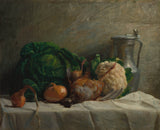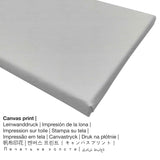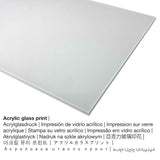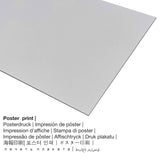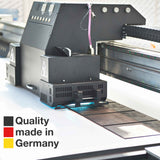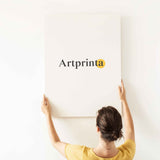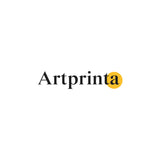Adolphe-Félix Cals, 1858 - Ndụ ka nwere akwụkwọ nri, Partridge na jug - mbipụta nka mara mma.
Ụtụ gụnyere. Mbupu gbakọrọ na ndenye ọpụpụ.
Họrọ ngwa ngwaahịa ọkacha mmasị gị
Maka mbipụta nka ọ bụla, anyị na-enye nha & ihe dị iche iche. Họrọ nha na ihe kacha amasị gị n'ime nhọrọ ndị a:
- Mbipụta kwaaji: A canvas direct print is a printed canvas mounted on a wood stretcher. Additionally, a canvas produces a nice and warm impression. Your canvas of this artpiece will provide you with the chance to turn your individual art print into a large size artwork as you would see in a gallery. The advantage of canvas prints is that they are relatively low in weight, which means that it is quite simple to hang your Canvas print without extra wall-mounts. A canvas print is suitable for all types of walls.
- Mbipụta ọla (aluminium dibbond): An Aluminium Dibond print is a material with an impressive depth effect. Colors are luminous and vivid, fine details of the print appear clear and crisp, and there’s a matte look you can literally feel.
- Mbipụta iko acrylic (nke nwere ezigbo mkpuchi iko): An print on acrylic glass, often denoted as a plexiglass print, will turn the artwork into beautiful décor and forms a good alternative to aluminium or canvas art prints. Your own version of the work of art is custom-made thanks to the help of state-of-the-art UV print technology. The major upside of a plexiglass fine art print is that sharp contrasts and also painting details will be more identifiable due to the subtle gradation in the print. Our acrylic glass protects your chosen fine art print against light and heat for up to 60 years.
- Poster (akwa akwa akwa): The poster is a UV printed sheet of cotton canvas paper with a slight surface structure, which resembles the original artwork. It is particularly designed for putting the art replica with a customized frame. Please keep in mind, that depending on the absolute size of the poster print we add a white margin of approximately 2-6cm round about the print motif, which facilitates the framing with your custom frame.
Nkwupụta iwu: We try our best to depict our products with as many details as possible and to illustrate them visually in our shop. At the same time, the colors of the printed materials and the imprint might vary slightly from the representation on the device's monitor. Depending on your screen settings and the nature of the surface, colors may not be printed 100% realistically. Since our fine art prints are processed and printed manually, there might also be slight differences in the motif's exact position and the size.
Ozi mgbakwunye site na ihe ngosi nka (© - Ụlọ ihe ngosi nka nke Cleveland - Velọ ihe ngosi nka nke Cleveland)
During the 19th century, a number of painters used common objects (rather than rare or refined objects), to create still lifes that some critics judged as unfit for the drawing room: studies of carrots, cabbages, asparagus, oysters, onions, eggs, and cooking utensils. Often these subjects were chosen for their mealtime associations. The food represented on the table in this painting--a partridge, onions, and cabbage--are the main ingredients for the making of the well-known dish, perdrix au chou (partridge with cabbage). Cals, however, was also interested in exploring underlying compositional design principles and studying the shapes of the objects he depicted.
Nkọwa ngwaahịa nka
Still Life with Vegetables, Partridge, and a Jug is a painting painted by Adolphe-Félix Cals. The 160 year-old version of the artwork was painted with the size: Emebereghị: 49,5 x 61 cm (19 1/2 x 24 na). Mmanụ na akwa ákwà was used by the artist as the technique for the artwork. The original artwork is inscribed with the following text: signed upper left: Cals 1858. Taa, ọrụ nka bụ akụkụ nke Ụlọ ihe ngosi nka nke Cleveland mkpokọta nka, nke bụ otu n'ime ụlọ ngosi ihe mgbe ochie na-ewu ewu n'ụwa niile na-ewu, na-echekwa, na-amụ ihe, ma na-ekesa mkpokọta nka ya pụtara ìhè site n'oge niile na akụkụ nke ụwa, na-ewepụta agụmakwụkwọ na nghọta ọhụrụ, ebe ọ na-eje ozi dị ka ebe mmekọrịta mmadụ na ibe ya na ọgụgụ isi maka ya. obodo. Nke a nkà nke oge a ngalaba ọha artpiece is being included with courtesy of The Cleveland Museum of Art. In addition, the artwork has the creditline: Bequest of Noah L. Butkin. On top of that, alignment of the digital reproduction is in odida obodo format na nwere akụkụ ruru nke 1.2: 1, nke pụtara na ogologo bụ 20% ogologo karịa obosara. The painter Adolphe-Félix Cals was a European artist from France, whose art style was primarily Impressionism. The Impressionist painter lived for 70 years - born in 1810 ma nwụọ na 1880.
Data nka ahaziri
| Aha nka: | "Still Life with Vegetables, Partridge, and a Jug" |
| Nhazi: | sere |
| Nhazi nka: | nkà nke oge a |
| Nhazi oge: | 19th narị afọ |
| Afọ okike: | 1858 |
| Afọ nka: | ihe karịrị 160 afọ |
| Usoro nka izizi: | mmanụ na akwa ákwà |
| Nha izizi (ọrụ nka): | Emebereghị: 49,5 x 61 cm (19 1/2 x 24 na) |
| Ederede nka nka izizi: | signed upper left: Cals 1858 |
| Egosiputara na: | Velọ ihe ngosi nka nke Cleveland |
| Ebe ebe ngosi nka: | Cleveland, Ohio, United States nke America |
| Weebụsaịtị nke ihe ngosi nka: | Velọ ihe ngosi nka nke Cleveland |
| Ikikere nke ihe osise: | ngalaba ọha |
| Site n'aka: | Velọ ihe ngosi nka nke Cleveland |
| Ebe E Si Nweta: | Arịrịọ nke Noa L. Butkin |
Ozi ihe ahaziri ahazi
| Ụdị ngwaahịa: | mmepụta nka |
| Mmeputakwa: | dijitalụ mmeputakwa |
| Usoro mmepụta: | UV kpọmkwem obibi |
| Mmalite ngwaahịa: | emepụtara na Germany |
| Stockdị ngwaahịa: | mmepụta ihe na-achọ |
| A na-atụ aro iji ngwaahịa eme ihe: | imewe ụlọ, ụlọ ihe osise nka |
| Nhazi: | usoro odida obodo |
| Oke akụkụ onyonyo: | 1.2: 1 - ogologo: obosara |
| Nsonaazụ nke oke onyonyo: | ogologo bụ 20% ogologo karịa obosara |
| Ụdị ihe dị iche iche dị: | ígwè ebipụta (aluminium dibond), acrylic glass print (nwere ezigbo mkpuchi iko), mbipụta akwụkwọ mmado (akwụkwọ kwaaji), akwụkwọ akwa akwa. |
| Mpempe akwa akwa (akwa akwa na etiti ihe ndọtị) nha: | 60x50cm - 24x20", 120x100cm - 47x39", 180x150cm - 71x59" |
| Mpempe iko acrylic (nwere ezigbo mkpuchi iko) nha dị iche iche: | 60x50cm - 24x20", 120x100cm - 47x39", 180x150cm - 71x59" |
| Nhọrọ nke mbipụta akwụkwọ mmado (akwụkwọ kwaaji): | 60x50cm - 24x20", 120x100cm - 47x39" |
| Mpempe aluminom (aluminium dibond ihe) nha: | 60x50cm - 24x20", 120x100cm - 47x39" |
| Igwe onyonyo: | adịghị |
Tebụl nyocha nke onye na-ese ihe
| Aha onye nka: | Adolphe-Félix Cals |
| okike onye nka: | nwoke |
| Nationality: | French |
| Ọrụ: | onye na-ese ihe |
| Obodo obibi: | France |
| Otu nka: | omenkà nke oge a |
| Ụdị nke onye na-ese ihe: | Mmetụta |
| Afọ ọnwụ: | 70 afọ |
| Afọ ọmụmụ: | 1810 |
| Nwụrụ n'afọ: | 1880 |
© Nwebiisinka nke - Artprinta (www.artprinta.com)

